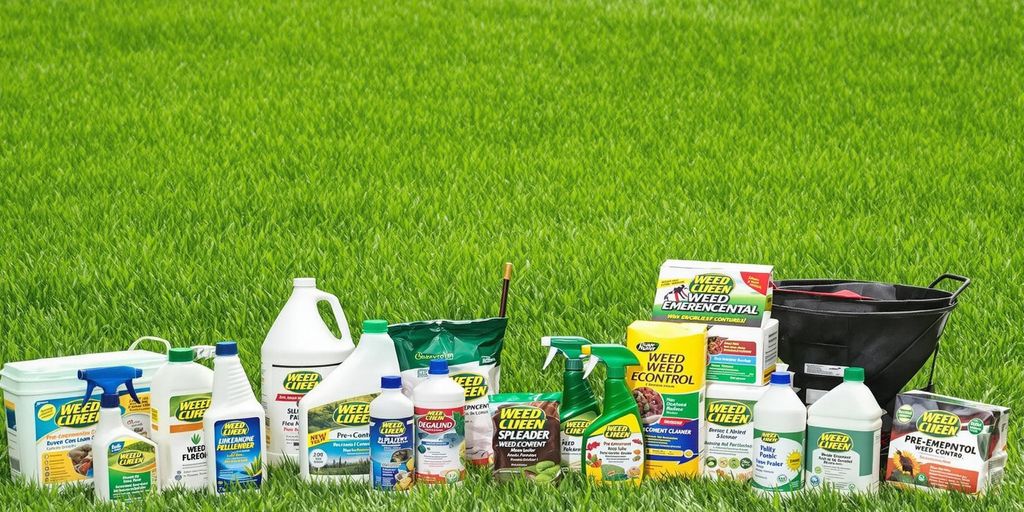
Keeping your lawn healthy and weed-free can feel like a full-time job, especially when those pesky weeds keep popping up. Pre-emergent weed control products are a game-changer, stopping weeds before they even have a chance to grow. But with so many options out there, it can be tricky to figure out what’s best for your yard. Let’s break down the types of pre-emergent weed control products you can use in 2025 and how to make them work for you.
Key Takeaways
- Pre-emergent products stop weeds before they sprout, making them a great preventative tool.
- Organic options use natural ingredients but may need more frequent applications.
- Chemical-based products are highly effective but require careful handling to ensure safety.
- Granular and liquid pre-emergents each have their pros and cons, depending on your lawn’s needs.
- Timing and proper application are key to getting the best results from any pre-emergent product.
Understanding Pre-Emergent Weed Control

How Pre-Emergent Products Work
Pre-emergent weed control products are like a protective shield for your lawn. They work by creating a barrier in the soil that prevents weeds from sprouting and growing. Unlike post-emergent, which kill weeds after they’ve already popped up, pre-emergent stop the problem before it starts. Most of these products disrupt the weed seeds’ ability to germinate, ensuring they never break through the soil’s surface.
For example, pre-emergent herbicides are specifically designed to inhibit weed growth early on, saving you the hassle of dealing with mature weeds later. To ensure your lawn stays healthy and weed-free, check out our services for professional treatment and maintenance.
Benefits of Using Pre-Emergent Weed Control
Using pre-emergent products comes with a bunch of perks:
- Saves time and effort: No need to pull out weeds by hand or repeatedly apply post-emergent solutions.
- Protects your lawn’s appearance: Keeps your yard looking clean and well-maintained.
- Reduces competition for nutrients: Stops weeds from stealing water, sunlight, and nutrients meant for your grass.
When applied correctly, these products can make lawn care way simpler and more efficient.
Common Misconceptions About Pre-Emergent Products
There are a few myths that need busting when it comes to pre-emergents:
- “They kill existing weeds.” Nope, they don’t. Pre-emergents only work on seeds before they sprout. If you already see weeds, you’ll need a different solution.
- “One application lasts forever.” Not true. Most pre-emergents need to be reapplied periodically, depending on the product and your region.
- “They harm all plants.” While some folks worry about this, pre-emergents are designed to target weed seeds specifically, leaving your grass and established plants unharmed.
Getting the timing right is key with pre-emergents. Apply them too early or too late, and they won’t be as effective. Always read the label and follow the instructions for the best results. Need expert lawn care? Call us today for professional assistance!
Organic Pre-Emergent Weed Control Options
Natural Ingredients in Organic Products
Organic pre-emergent weed control products rely on natural ingredients to block weed seeds from sprouting. One popular option is corn gluten meal, which not only prevents weeds but also adds a bit of nitrogen to the soil. Ingredients like clove oil and vinegar are also common in organic weed control solutions. These natural elements work by creating an environment where weed seeds struggle to germinate. This makes them a safer choice for families, pets, and the environment.
Effectiveness of Organic Weed Control
Organic options can be just as effective as chemical ones when applied correctly. However, they often require a bit more diligence. For instance, timing is everything—applying an organic pre-emergent too early or too late can reduce its effectiveness. Keep in mind that organic products might need reapplication more frequently, especially in areas with heavy weed pressure.
Best Practices for Applying Organic Pre-Emergent
To get the most out of organic pre-emergent products, follow these steps:
- Prepare the soil: Remove existing weeds and debris to give the product a clean slate to work on.
- Apply at the right time: Early spring or fall is usually ideal, depending on the weeds you’re targeting.
- Water it in: Many organic pre-emergents need moisture to activate, so a light watering after application is often recommended.
Organic weed control isn’t just about eliminating weeds—it’s about creating a healthier lawn ecosystem. By improving soil health and using natural solutions, you can manage weeds while keeping your yard eco-friendly.
For more on embracing these methods, check out organic weed control methods.
Chemical-Based Pre-Emergent Weed Control Products

Key Ingredients in Chemical Pre-Emergent
Chemical pre-emergent products are packed with powerful active ingredients that create a barrier in the soil, stopping weed seeds from germinating. Prodiamine, for instance, is a widely used ingredient for its ability to prevent both grassy and broadleaf weeds effectively. Some products also include dithiopyr or pendimethalin, which target specific types of weeds based on their growth patterns. These chemicals are designed to last for weeks, giving your lawn extended protection.
| Ingredient | Targets | Longevity (weeks) |
| Prodiamine | Grassy and broadleaf weeds | 8-12 |
| Dithiopyr | Crabgrass and annual weeds | 6-10 |
| Pendimethalin | Broad-spectrum weed prevention | 6-8 |
Safety Tips for Using Chemical Products
When working with chemical pre-emergents, safety should always come first. Here are a few tips to keep in mind:
- Always wear gloves and protective eye-wear when handling these products.
- Avoid applying on windy days to reduce the risk of drift onto desirable plants.
- Follow the label instructions carefully, especially regarding application rates and timing.
- Keep pets and children off treated areas until the product has been watered in and dried completely.
Applying chemical pre-emergents correctly not only protects your lawn but also ensures the safety of your family and the environment.
Environmental Impact of Chemical Weed Control
While chemical pre-emergents are highly effective, they can have some impact on the environment if not used responsibly. Runoff from treated areas can end up in waterways, potentially harming aquatic life. Choosing products with controlled-release technology, like professional-grade Prodiamine weed control, can minimize these risks by reducing the likelihood of leaching. Additionally, applying the right amount at the right time helps ensure the product stays where it’s needed—in your lawn.
By balancing effectiveness with responsible usage, chemical pre-emergents can be a valuable tool in maintaining a weed-free lawn while minimizing environmental concerns.
Granular vs. Liquid Pre-Emergent Products
Advantages of Granular Pre-Emergent
Granular pre-emergents are a go-to choice for many lawn enthusiasts. These products come in small, dry particles that you spread across your lawn, usually with a broadcast or drop spreader. One big plus? They’re easy to apply, especially on larger lawns. Granular options are also less likely to wash away during heavy rains if applied correctly. Plus, they’re great for areas with freezing conditions, where liquids might not be practical.
Here are some benefits of granular pre-emergents:
- Simple to store and handle.
- Ideal for covering large areas evenly.
- Often combined with fertilizers for dual-purpose application.
When to Choose Liquid Pre-Emergents
Liquid pre-emergent products are all about precision. They’re typically mixed with water and sprayed using a garden sprayer, making them perfect for targeting specific areas. If you’re dealing with tricky spots like flower beds or areas near sidewalks, liquids might be your best bet. They also provide more even coverage, especially when applied with a high-quality sprayer.
Key reasons to pick liquid pre-emergents:
- Easier to apply evenly on uneven terrain.
- Better for spot-treating problem areas.
- Quick absorption into the soil, reducing the risk of runoff.
Application Techniques for Each Type
Proper application is crucial for getting the most out of your pre-emergent, whether it’s granular or liquid. For granular products, use a spreader to ensure even distribution. Walk at a steady pace, and avoid overlapping too much to prevent over-application. With liquids, make sure to calibrate your sprayer for even coverage and avoid applying during windy conditions.
| Feature | Granular Pre-Emergents | Liquid Pre-Emergents |
| Best for | Large areas, general coverage | Precision, spot treatments |
| Application Method | Spreader | Sprayer |
| Weather Suitability | Freezing conditions | Dry, calm weather |
Choosing between granular and liquid pre-emergents often comes down to your lawn’s specific needs and your personal preference. Both have their strengths, so understanding when and how to use each can make a big difference in your weed control strategy.
For more insights into selecting the best herbicides best herbicides for effective weed prevention, consider factors like climate, lawn size, and the types of weeds you’re targeting.
Seasonal Considerations for Pre-Emergent Weed Control
Spring Pre-Emergent Application Tips
Spring is the prime time to get ahead of weeds before they even think about sprouting. Timing is everything here. Aim to apply pre-emergent products when soil temperatures hit around 50°F for several consecutive days. This is usually right before weeds like crabgrass start germinating. If you wait too long, the weeds might already be growing, and pre-emergents won’t help.
To make it easier, here’s a quick checklist for spring applications:
- Check local soil temperature trends online or with a soil thermometer.
- Mow your lawn a few days before applying pre-emergents.
- Water the lawn lightly after application to help the product activate.
Fall Pre-Emergent Strategies
Fall is another key season for tackling weeds, especially those that germinate when temperatures cool down, like annual bluegrass or chickweed. The window for applying fall pre-emergents is a bit narrower compared to spring. You’ll want to time it just before the first frost or when daytime temps consistently drop below 70°F.
For fall, consider these steps:
- Focus on areas of the lawn where you’ve noticed weed problems in the past.
- Avoid aerating your lawn right after applying pre-emergents—it can break the barrier they create.
- Plan to overseed your lawn? Skip the pre-emergent, as it can prevent grass seed from sprouting too.
Adjusting for Regional Climate Differences
Not all regions follow the same seasonal patterns, so knowing your local climate is key. For example:
- In warmer southern areas, you might need to apply pre-emergents earlier in spring and later in fall.
- Cooler northern climates often have shorter windows, so keep a close eye on weather changes.
- Regions with unpredictable weather may require a bit of guesswork, but erring on the earlier side is usually safer.
Flexibility is important here. If you’re unsure, try splitting your applications into two smaller doses a few weeks apart. This can help cover any unexpected shifts in weather. If you need expert guidance, don’t hesitate to contact us for professional advice and support.
Pre-emergent weed control isn’t a one-size-fits-all deal. Pay attention to your local conditions, and you’ll see better results with less frustration.
Specialized Pre-Emergent Products for Different Weeds
Targeting Crabgrass with Pre-Emergents
Crabgrass is one of those weeds that can take over your lawn if you’re not careful. The key to stopping it is applying a pre-emergent before the seeds germinate. Look for products specifically labeled for crabgrass prevention. Many of these contain ingredients like dithiopyr or prodiamine, which create a barrier in the soil to stop seeds from sprouting. Timing is everything here—apply when soil temperatures hit 55°F for a few days in a row.
Products for Broad-leaf Weed Prevention
Broad-leaf weeds, like dandelions and clover, require a different approach. Pre-emergent products designed for these weeds often include isoxaben, which is effective in preventing their seeds from taking root. These products are great for lawns that have had trouble with broadleaf weeds year after year. Make sure to follow up with consistent lawn care to keep the weeds from reappearing.
Dealing with Perennial Weeds
Perennial weeds are a tougher challenge because they don’t just grow from seeds—they come back from existing roots. For these, you’ll need a pre-emergent that targets both seeds and root systems. Voraxor 3.13SC is a newer option combining saflufenacil with a novel PPO inhibitor. It’s designed for residual control of broadleaf weeds and works well for perennial varieties. Apply it carefully, as these products can sometimes affect nearby plants if not used correctly.
Specialized pre-emergent products are like tailored solutions for your lawn’s unique challenges. They save you time and effort by focusing on the exact weeds you’re dealing with.
Combining Pre-Emergent Products with Lawn Care Practices
Mowing and Fertilizing Around Pre-Emergent Use
When using pre-emergent products, timing your mowing and fertilizing is key. For best results, avoid mowing the lawn immediately before or after applying pre-emergent herbicides. This ensures the product stays on the soil surface where it can form a protective barrier. Fertilizing your lawn a week before application can help strengthen your grass, making it more resilient to weeds. Proper scheduling keeps your lawn healthy while maximizing the effectiveness of weed prevention. Contact us for expert lawn treatment services !
Watering Guidelines for Treated Lawns
Watering plays a huge role in activating pre-emergent products. Most require a light watering after application to help them penetrate the soil and create that protective layer. However, over-watering can wash the product away, reducing its effectiveness. Stick to your lawn’s regular watering schedule, but ensure the soil stays moist—not soaked. Consistency is your best friend here.
Integrating Pre-Emergents into a Lawn Care Schedule
Pre-emergent herbicides work best when they’re part of a broader lawn care routine. Start by planning your applications around the growing season of weeds in your area. For example, apply early in the spring for crabgrass or in the fall for winter weeds. Combine this with regular mowing, fertilizing, and watering for a lawn that’s both lush and weed-free. Here’s a simple checklist to follow:
- Apply pre-emergents at the right time for your region and weed type.
- Mow and fertilize a week before application.
- Follow up with light watering to activate the product.
- Monitor your lawn and reapply as needed based on the product’s directions.
A well-maintained lawn is your best defense against weeds. Pair pre-emergents with solid care for a healthy yard. Contact us for lawn pest control services!
Wrapping It Up
So, there you have it. Pre-emergent weed control products come in all sorts of options, and picking the right one really depends on your lawn and what you’re dealing with. Whether you go for a granular product or a liquid spray, the key is to apply it at the right time and follow the instructions. It might take a little trial and error, but once you find what works, your lawn will thank you. No one wants to spend their weekends pulling weeds, right? Hopefully, this gave you a better idea of what’s out there and how to keep those pesky weeds in check.
We focus on customer satisfaction and work closely with you to keep your yard healthy and beautiful. Our years of experience in lawn care make us the preferred choice for both households and businesses. Call us now to schedule your service and give your lawn the care it deserves!
Frequently Asked Questions
What is pre-emergent weed control?
Pre-emergent weed control involves using products that stop weeds from growing before they sprout. These products create a barrier in the soil to prevent weed seeds from germinating.
When should I apply pre-emergent products?
The best time to apply pre-emergent products is early in the spring or fall, depending on the type of weeds you’re targeting. Timing is important to stop weeds before they start growing.
Are organic pre-emergent products as effective as chemical ones?
Organic pre-emergent products can work well, but their effectiveness may vary. They are a good choice for those looking for natural alternatives, but they might not last as long as chemical options.
Can pre-emergent products harm my lawn?
If used correctly, pre-emergent products are safe for your lawn. However, over-application or applying them at the wrong time can cause damage.
What’s the difference between granular and liquid pre-emergents?
Granular pre-emergents are easy to spread and work well for large areas. Liquid pre-emergents are better for targeted applications and can be mixed with water for even coverage.
Do I need to water my lawn after applying pre-emergents?
Yes, watering helps activate the pre-emergent barrier in the soil. Be sure to follow the product’s instructions for the best results.
